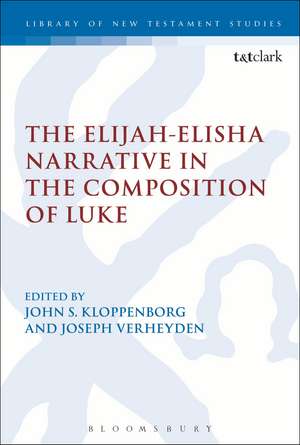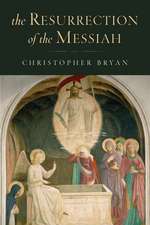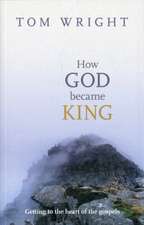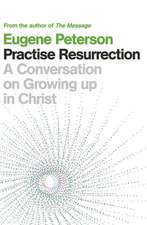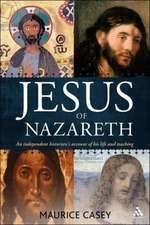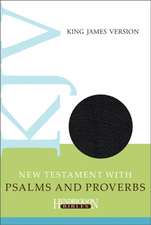The Elijah-Elisha Narrative in the Composition of Luke: The Library of New Testament Studies
Editat de Professor John S. Kloppenborg, Joseph Verheydenen Limba Engleză Paperback – 20 mai 2015
| Toate formatele și edițiile | Preț | Express |
|---|---|---|
| Paperback (1) | 255.58 lei 43-57 zile | |
| Bloomsbury Publishing – 20 mai 2015 | 255.58 lei 43-57 zile | |
| Hardback (1) | 772.17 lei 43-57 zile | |
| Bloomsbury Publishing – 6 noi 2013 | 772.17 lei 43-57 zile |
Din seria The Library of New Testament Studies
- 34%
 Preț: 509.52 lei
Preț: 509.52 lei - 22%
 Preț: 832.58 lei
Preț: 832.58 lei - 22%
 Preț: 832.09 lei
Preț: 832.09 lei - 24%
 Preț: 190.33 lei
Preț: 190.33 lei - 22%
 Preț: 832.65 lei
Preț: 832.65 lei - 23%
 Preț: 191.31 lei
Preț: 191.31 lei -
 Preț: 221.70 lei
Preț: 221.70 lei -
 Preț: 98.92 lei
Preț: 98.92 lei - 31%
 Preț: 830.87 lei
Preț: 830.87 lei - 22%
 Preț: 834.60 lei
Preț: 834.60 lei - 22%
 Preț: 831.59 lei
Preț: 831.59 lei - 30%
 Preț: 717.05 lei
Preț: 717.05 lei - 22%
 Preț: 835.03 lei
Preț: 835.03 lei - 30%
 Preț: 511.40 lei
Preț: 511.40 lei - 24%
 Preț: 190.33 lei
Preț: 190.33 lei -
 Preț: 158.77 lei
Preț: 158.77 lei - 30%
 Preț: 510.04 lei
Preț: 510.04 lei - 22%
 Preț: 832.99 lei
Preț: 832.99 lei - 30%
 Preț: 509.52 lei
Preț: 509.52 lei - 22%
 Preț: 832.80 lei
Preț: 832.80 lei - 22%
 Preț: 831.76 lei
Preț: 831.76 lei - 22%
 Preț: 834.93 lei
Preț: 834.93 lei - 22%
 Preț: 831.59 lei
Preț: 831.59 lei - 22%
 Preț: 832.41 lei
Preț: 832.41 lei - 22%
 Preț: 832.99 lei
Preț: 832.99 lei -
 Preț: 414.71 lei
Preț: 414.71 lei - 30%
 Preț: 773.65 lei
Preț: 773.65 lei - 22%
 Preț: 834.93 lei
Preț: 834.93 lei - 14%
 Preț: 511.81 lei
Preț: 511.81 lei -
 Preț: 222.16 lei
Preț: 222.16 lei - 30%
 Preț: 775.67 lei
Preț: 775.67 lei - 30%
 Preț: 1012.49 lei
Preț: 1012.49 lei - 30%
 Preț: 509.02 lei
Preț: 509.02 lei - 30%
 Preț: 656.90 lei
Preț: 656.90 lei -
 Preț: 469.92 lei
Preț: 469.92 lei -
 Preț: 471.68 lei
Preț: 471.68 lei -
 Preț: 173.21 lei
Preț: 173.21 lei - 30%
 Preț: 833.64 lei
Preț: 833.64 lei - 22%
 Preț: 834.93 lei
Preț: 834.93 lei - 31%
 Preț: 772.17 lei
Preț: 772.17 lei - 30%
 Preț: 774.20 lei
Preț: 774.20 lei - 14%
 Preț: 1124.92 lei
Preț: 1124.92 lei - 22%
 Preț: 948.51 lei
Preț: 948.51 lei - 14%
 Preț: 1128.84 lei
Preț: 1128.84 lei - 31%
 Preț: 1065.91 lei
Preț: 1065.91 lei - 22%
 Preț: 777.71 lei
Preț: 777.71 lei - 31%
 Preț: 1064.84 lei
Preț: 1064.84 lei - 22%
 Preț: 1063.44 lei
Preț: 1063.44 lei - 22%
 Preț: 889.49 lei
Preț: 889.49 lei - 22%
 Preț: 1006.06 lei
Preț: 1006.06 lei
Preț: 255.58 lei
Preț vechi: 294.38 lei
-13% Nou
Puncte Express: 383
Preț estimativ în valută:
48.90€ • 51.20$ • 40.47£
48.90€ • 51.20$ • 40.47£
Carte tipărită la comandă
Livrare economică 07-21 aprilie
Preluare comenzi: 021 569.72.76
Specificații
ISBN-13: 9780567663658
ISBN-10: 0567663655
Pagini: 184
Dimensiuni: 156 x 234 x 25 mm
Greutate: 0.27 kg
Editura: Bloomsbury Publishing
Colecția T&T Clark
Seria The Library of New Testament Studies
Locul publicării:London, United Kingdom
ISBN-10: 0567663655
Pagini: 184
Dimensiuni: 156 x 234 x 25 mm
Greutate: 0.27 kg
Editura: Bloomsbury Publishing
Colecția T&T Clark
Seria The Library of New Testament Studies
Locul publicării:London, United Kingdom
Caracteristici
Takes a current debate and examines from both sides
Notă biografică
John S. Kloppenborg is Professor of Religion at the University of Toronto, Canada. He is well-known for his ground-breaking work on the Sayings Gospel Q. His most recent publication is Excavating Q: The History and Setting of the Sayings Gospel. He is currently writing a commentary on James for the Hermeneia series.Joseph Verheyden is Professor of New Testament Studies at the University of Leuven, Belgium. He has recently edited The Figure of Solomon in Jewish, Christian and Islamic Tradition: King, Sage and Architect (2013) and (with J.W. van Henten), Early Christian Ethics in Interaction with Jewish and Greco-Roman Contexts (2013).
Cuprins
Introduction - John S Kloppenborg, University of Toronto, Canada Luke's Use of the Elijah-Elisha Narrative - Thomas L. Brodie, Dominican Biblical Institute, Limerick, IrelandA Response to Thomas Brodie, 'Luke's Use of the Elijah-Elisha Narrative' - Robert A. Derrenbacker, Thorneloe University, Canada A Response to Thomas Brodie's Proto-Luke as the Earliest Form of the Gospel - David Barrett Peabody, Nebraska Wesleyan University, USA The Healing of Naaman (2 Kgs 5:1-19) as a Central Component for the Healing of the Centurion's Slave (Luke 7:1-10) - John Shelton, Dominican Biblical Institute, Limerick, IrelandA Rhetorical-Critical Assessment Luke's Use of the Elijah-Elisha Narrative - Alexander Damm, Wilfrid Laurier University, Canada Imitation and Emulation, Josephus and Luke: Plot and Psycholinguistics - F. Gerald Downing, University of Manchester, UK Toward an Intertextual Commentary on Luke 7 - Dennis R. MacDonald, Claremont School of Theology, USA Epilogue - Joseph Verheyden, Katholiek University Leuven, Belgium Bibliography Index
Recenzii
This collection of essays from prominent North American and European scholars offers a much-needed critical discussion of Luke's use of the Elijah-Elisha narrative (1 Kings 16:29-2 Kings 13) . Because it includes a diverse collection of scholarly reflections on the extent of Luke's use of the Elijah-Elisha narrative, this volume both offers well-reasoned points and counterpoints within which future studies can situate themselves and also suggests potential avenues for fruitful investigation
